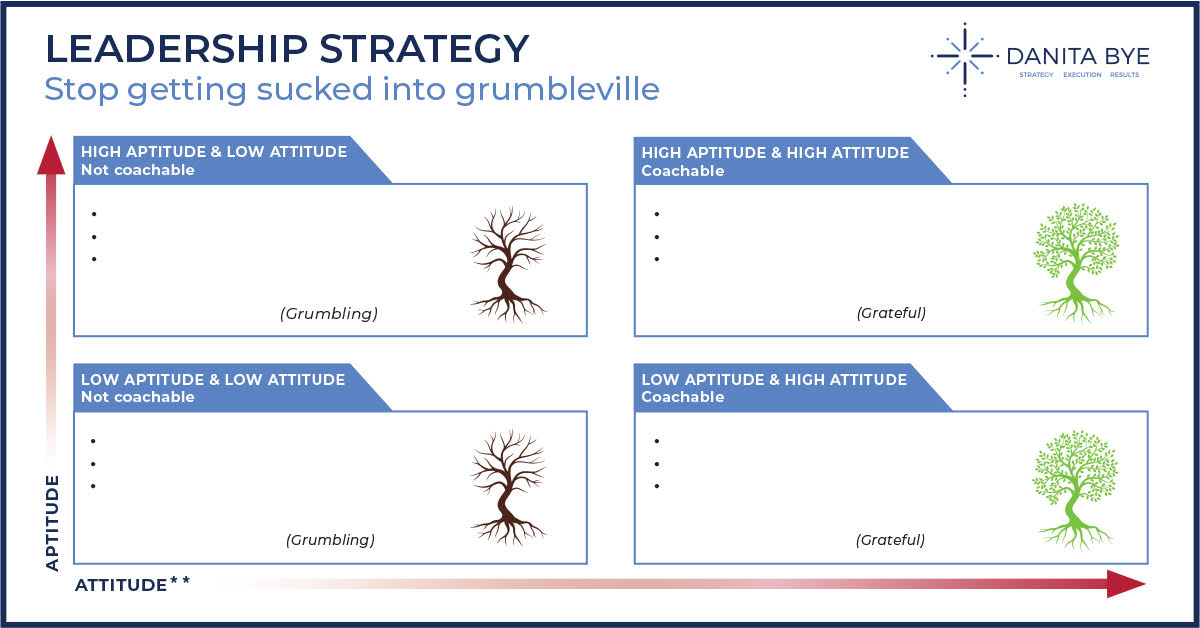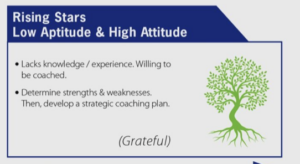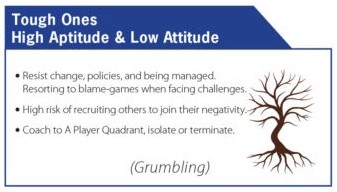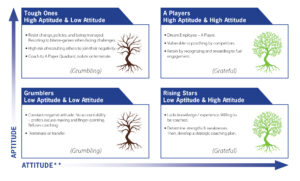
Navigating Grumbler Territory: Leadership Strategy for Positive Change (Aptitude/Attitude 2 X 2 Framework)
In our fast-paced world, leadership development success isn’t guaranteed. Take John, for example, founder and president of a software company. His company should be soaring, but it’s stuck.
One big issue – finding and keeping top talent. For growth, having the right people is crucial. But for John, hiring skilled workers is tough. And once he sees them, keeping them is even tougher. It’s like trying to hold onto water in a leaky bucket. How do you do that?
Then there’s the pressure to keep up with technology. Business moves fast. Companies need to stay ahead. But John’s company struggles to adapt. Old systems slow things down.
Then, the most frustrating problem: The grumblers!
John’s not the only one dealing with this issue. When experts survey salespeople and sales leaders, 60% score as excuse-makers, or grumblers. 60%! It appears that John has some on his team.

“Grumblers, the employees who incessantly criticize, condemn, and complain, are like anchors dragging down the ship of progress. Their negative attitudes create a toxic atmosphere. Creativity, collaboration, and productivity are stifled. Instead of focusing on finding solutions, grumblers dwell on problems, spreading pessimism like wildfire among their colleagues.
Their constant griping not only erodes morale but also undermines the company’s reputation both internally and externally. Internally, grumblers sow seeds of doubt and discontent, making it difficult for teams to work together effectively. Externally, their negative energy can tarnish the company’s image, driving away potential clients, partners, and even top talent.
Moreover, grumblers drain valuable time and resources with their complaints, diverting attention away from strategic initiatives and essential tasks. Their refusal to take ownership of their actions and embrace a solutions-oriented mindset keeps the business from reaching its full potential.
Unless addressed proactively, grumblers can become a significant barrier to growth and success, hindering innovation, driving away top talent, and undermining the company’s ability to thrive in today’s competitive landscape.”
Yikes! That’s bad news!
So what do you do about it? What are some coaching strategies?
I’m republishing this article at the request of numerous clients who find this process helpful in coaching.
A Leadership Strategy to Stop Getting Sucked into Grumbleville
What leadership strategy do you use when dealing with a Grumbler? How does a Grumbler differ from The Tough Ones? How do you determine if they are a Visitor or Permanent Resident?
And, how might you coach a Rising Star? Or retain A Players?
How might the Aptitude/Attitude Coaching Guide provide clarity?
I’m a fan of the work of Caroline Leaf, a cognitive neuroscientist and author. In “Switch on Your Brain: The Key to Peak Happiness, Thinking, and Health,” Leaf uses the metaphor of a “brain tree” to describe the impact of thoughts on our brains:
- Focusing on the negative (and fear) creates dead branches.
- Shifting our thoughts to the positive (i.e gratitude and love), births new neural pathways. It’s a flourishing brain tree with new branches and leaves.
Let’s discover how you can use this analogy to fight the Grumble Culture and unlock the leadership performance and sales results you want.
Stop Getting Sucked into Grumbleville
You’ve been there before. You know the dangers of Grumbleville. It’s a dark abyss where everyone resorts to criticizing, condemning, and complaining.
That’s exactly what frustrated John, the president of a software company.
I get his “911 call” early one morning.
He sounds unsettled and panicky as he says, “Danita, help me! I’m at the end of my rope! I don’t know what to do with this salesperson.”
I try to calm John down and say, “Okay, let’s start from scratch!” As I ask questions, I soon realize that John is getting sucked into Grumbleville.
Anna, the salesperson, has a promising track record. But, she isn’t delivering sales results.
Whenever John talks about her performance, she has an excuse. She has a long list of complaints about what went array last week, last month, and last quarter:
- The Board of Directors messed up.
- The marketing team’s strategy is weak.
- The accounting team made mistakes…again.
In short, she’s trying to drive forward, but her eyes are stuck staring at the rearview mirror!
John is ready to fire Anna. His problem – she is well-liked by the team, and has a broad network in the industry. Is firing his only option? Or, is there a coaching strategy to get Anna back on track? If yes, what would it be?
3 Steps to Tackle Leadership Challenges
A new level of gratitude unlocks a new level of leadership influence. Yet, there are times when the obstacles we face are so severe, that it takes grit to be grateful!
John and I create a 2 X 2 matrix, The Aptitude vs. Attitude Coaching Guide:
- The vertical axis, Aptitude, represents skills, activity level, and production levels.
- The horizontal axis, Attitude, represents mindsets, and coachability. In this case, gratitude.
How might John use this 2 X 2 coaching matrix to get a grumbling Anna back on track?
Step 1: Identify which quadrant describes the current aptitude and attitude of your leader. This clarity brings direction to your leadership development conversations.
Step 2: Ask the critical questions that determine the risk of keeping this person. This will assist you in identifying who’s coachable and who needs to go.
Step 3: Develop a tailored coaching strategy for the coachable salesperson. Base this plan on their strengths and weaknesses. There’s no one-size-fits-all coaching strategy that will work for every member of your team. For those who are not coachable…well, it’s time to make the difficult decision – let them go!
So, let’s take a closer look at the Aptitude vs. Attitude Coaching Guide. Each block in the quadrant reveals insightful information.
A Players – Upper Right Quadrant

Aptitude: They stand out as your top performers. Your A Players fulfill their leadership responsibilities and produce results. They are adept at aligning resources and are highly skilled at motivating others. Their creative and innovative thinking sets them apart. They are great problem-solvers.
Attitude: Your A Players moved to Gratitude-Ville a long time ago. They are resilient, optimistic, and grateful. They contribute to a healthy, productive culture in your organization. They may venture into a winter season of life and visit Grumbleville. Even then, they handle their challenges with productive responses.
Critical Question to Determine Risk: Their strong attributes make them attractive to your competitors. What’s your retention strategy? How are you recognizing and rewarding them for their contribution to the team, and your vision?
Action: Have an in-depth conversation with them about their personal and professional goals. What are their dreams? Their aspirations? How might you help them achieve their goals?
Rising Stars – Lower Right Quadrant

Aptitude: Their lack of results is often due to inexperience. There could be gaps in their selling mindsets. Are they uncomfortable talking about money? Do they have a high need for approval? Do they stall out in helping others make decisions?
Attitude: A Rising Star is a leadership development coach’s ideal candidate. What they lack in aptitude, Rising Stars make up for with a great attitude. Their growth mindset positively contributes to the company culture. During coaching conversations, they embrace and welcome a leadership strategy that grow their capacity. They are hungry to upgrade their Attitude, Activity, and Skill (A.A.S. Theory of Sales Management) so that they can improve their results.
Critical Question to Determine Risk: What might they do to develop the skills required to improve performance?
Action: A skills assessment objectively identifies the Rising Star’s strengths and weaknesses. Armed with these insights, the Rising Star can chart their growth path. With strategic coaching and training, they flourish and join your top performers. Work with them to create a measurable action plan. Identify strengths to harness. Also, talk about a strategy for improvement. Do you need to create stronger systems and processes to support their efforts? Or, do they need to stretch themselves? Or, both? Rising Stars are hungry to learn and grow. They will reward your investment of time and attention with progress.
The Grumblers – Lower Left Quadrant

Die-Hard Grumblers – well, at least it’s easy to identify them! They’re not even trying to put on a happy mask! They’re not getting sales and they are openly (and loudly) grumbling…all the time!
Undercover Grumblers – I sometimes refer to them as the Sneaky Grumblers! They can put on a happy face – when they feel like it! They show up and punch the clock. They do the work you ask them to do, but nothing more. When you try to coach them, they smile and pretend they’re going to follow through. But they don’t. They are status quo players and never change their behavior.
For both Die-Hard and Undercover Grumblers, the Aptitude / Attitude assessment paints a bleak picture:
Aptitude: A low skill level shows up in the poor performance of all Grumblers. They’re always missing targets, rarely set personal or professional goals, and don’t do what it takes to succeed.
Attitude: Grumblers are constantly criticizing, condemning, and complaining. There’s always something wrong, something missing. Whether it’s on a personal or professional level, someone or something else is always to blame. They’re in a negative rut. They are spiraling down, unwilling to take coaching, and lack accountability. They are permanent residents of Grumbleville at this season of their lives.
Critical Question to Determine Risk: Is the grumbling a permanent attitude, that will spread to their colleagues?
Action: Based on your assessment, it’s time to face it! You’ve made a hiring mistake. Terminate or transfer them before their poison spreads.
The Tough Ones – Upper Left Quadrant:
The Tough Ones earned their name, not because THEY are so tough! It’s because they are so tough to manage and coach! They can be

Aptitude | Atttude_2x2 with text PROOF 3
sneaky too. One day, their brain tree looks completely dead. The next day they turn up for work, and…wait…what?? Is that new growth you’re seeing? Might their brain tree be alive after all? Because they are so elusive I had trouble deciding what to call this quadrant. These are some of the names I considered:
- Pull-your-hair-out quadrant,
- I-need-a-drink quadrant, and
- I-think-I-should-start looking-for-a-new-job quadrant.
Aptitude: The Tough Ones achieve results. They consistently exceed their targets.
Attitude: This is when leading gets tough! When confronted with challenges, Tough Ones resort to blame-gaming and finger-pointing. They are resistant to coaching. Their list of excuses seems never-ending.
To complicate matters, this quadrant involves three distinct sub-groups:
- The Mayor: As a top performer, the Mayor feels entitled to criticize, condemn, and complain. Their negative attitude affects the morale of everyone. They may get everyone riled up. Or they throw a dark, cloudy blanket on all vision and strategy discussions. This stunts the performance of the entire team. They push leaders to their limits. Leaders want to pull their hair out when dealing with them.
- Visitors: While delivering strong sales results, Visitors are in a season of complaining. Their colleagues will hear how tough it is to do their job and get results. The complaints can vary. It could range from how the marketing team messed up, to accounting, to R & D, to Quality Control. Often, it’s a customer who stumbled. And…my favorite – my manager is incompetent. Their constant critique stifles innovation and creativity. Forward momentum stalls. The good news is that this is only a season for them.
- Permanent Residents: They achieve their sales targets. But don’t expect a growth mindset. They are status quo players. They’re the first to knock on your door, telling you in detail about their problem. They’re expecting you to snap your fingers and fix it!
Critical Questions to Determine Risk: Your first task is to identify who you’re dealing with: the mayor of Grumbleville, a visitor, or a permanent resident. Your findings will determine the action you need to take.
Action: So, let’s look at the leadership coaching strategies to deal with these 3 types:
- The Mayor. This is a tough one. The choice often comes down to isolation or termination. This might be an excruciating decision if you only consider their sales performance. However, think about the negative impact their attitude brings on the entire team.
- Visitors: Delve into the root causes of their complaints. Personal issues may be affecting their attitude. Coach Visitors back into the upper right-hand quadrant of A Players.
- Permanent Residents: When a Permanent Resident offloads their problems onto you, act. It’s essential to use your leadership Influence and return the ball to their court. Here’s a powerful question that stimulates problem-solving. “What might YOU do to achieve the results you want?” Ask them to come up with three potential solutions. The emphasis here is on “three possible solutions.” When they come back with three options, walk through them together. Use these options to spark even more creative options. This approach encourages collaboration and strengthens an ownership mindset. If they are unwilling to take responsibility, it might be time to isolate them. If you don’t act, they drain your leadership energy, and you’ll want to pull your hair out! To learn more about this powerful question, “What might YOU do to achieve the results you want?” – check out this article series.
Coach Gratitude – It’s a Powerful Leadership Strategy to Improve Performance
A gratitude mindset enables one to focus on the future, and take ownership of Attitudes, Activities, and Skills ( A.A.S. Theory of Management).
So, back to John’s frustration with Anna’s performance.
John and I brainstormed about reframing Anna’s Complaints List. What might happen if we added a Gratitude statement at the end of each complaint?
- The Board is frustrating to deal with…and I’m grateful that they’ve given me valuable direction and input to fine-tune direction.
- The marketing team’s strategy is weak…and I’m grateful that we’ve discovered some valuable insights about our client database as we’ve been refining our message.
- That accounting mistake set us back a bit…and I’m grateful that we learned valuable lessons about how to resolve conflict that will help us move faster in the future.
Can you see what happened? The same Board of Directors, the same marketing team, and the same accounting department that was the core of the grumbling attitude, now become a stepping stone to moving forward.
Gratitude – and a focus on the positive – empowers a Next-Gen leader to grow their leadership and sales capacity. They begin looking towards the future, rather than getting stuck staring in the rearview mirror!
Embrace a Gratitude Leadership Strategy – Stop Grumbleville
A grateful mindset transforms people and workplaces. It instills hope, resilience, and a determination to overcome even seemingly insurmountable challenges.
John used The Aptitude vs. Attitude Coaching Guide and the 3 Steps:
Step 1: Identified which quadrant Anna currently lives in.
Step 2: Asked the critical questions that determine the way forward.
Step 3: Developed a strategic action plan so that Anna can grow her neural pathways to flourish and become resilient when facing challenges.
To keep up with the pace of change and turn your Grumblers into A Players, coach gratitude. Just like John, you can embrace it as a productive leadership strategy to get your emerging leaders unstuck from criticizing, condemning, and complaining.
Keep this principle in mind:
- Focusing on the negative (and fear) creates dead branches.
- Shifting our thoughts to the positive (i.e. gratitude and love), births new neural pathways. It’s a flourishing brain tree with new branches and leaves.
Your leadership matters, NOW, more than ever.
Additional Resources:
- You may also be interested in this eBook: Millennial Sales Accountability. Get it HERE.
- This article was posted in my recent Newsletter. Get a copy, more resources are available here.
Leadership Development Question: What might you do to use gratitude to build a top-notch team?
Copyright 2024, Danita Bye. All rights reserved.
Let’s discuss a tailor-made interview to meet your audience’s needs.
Virtual speaking event? No problem!
Check out my Speaker page HERE.
To schedule, a call contact me at danita@danitabye.com





Paul Cronin
Posted at h,Danita,
Your post nails it. In the Scaling Up coaching program we have a saying for this… “If you want to 10x your company your need to 10x your people.” At Cornerstone3inc and 10xstrategies we focus on getting the right people in the right seats and then help organizations grow and retain their people. Thanks for being spot on as usual.
Best regards,
Paul
Danita
Posted at h,This is so true, Paul! I’m grateful for your amazing leadership. With every client we’ve worked together on, you’ve brilliantly got the right people in the right seats focused on the right strategies for growth.